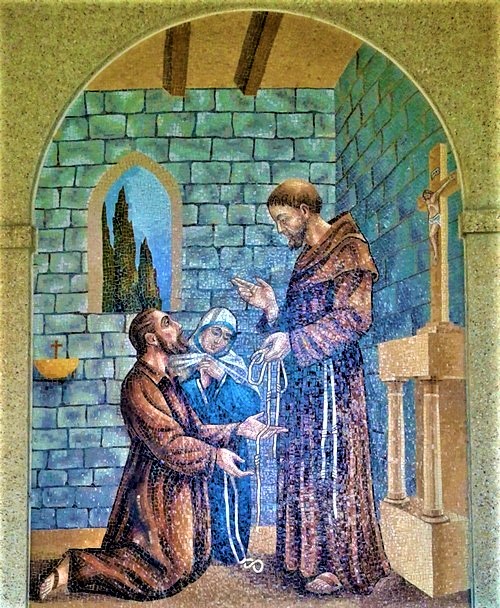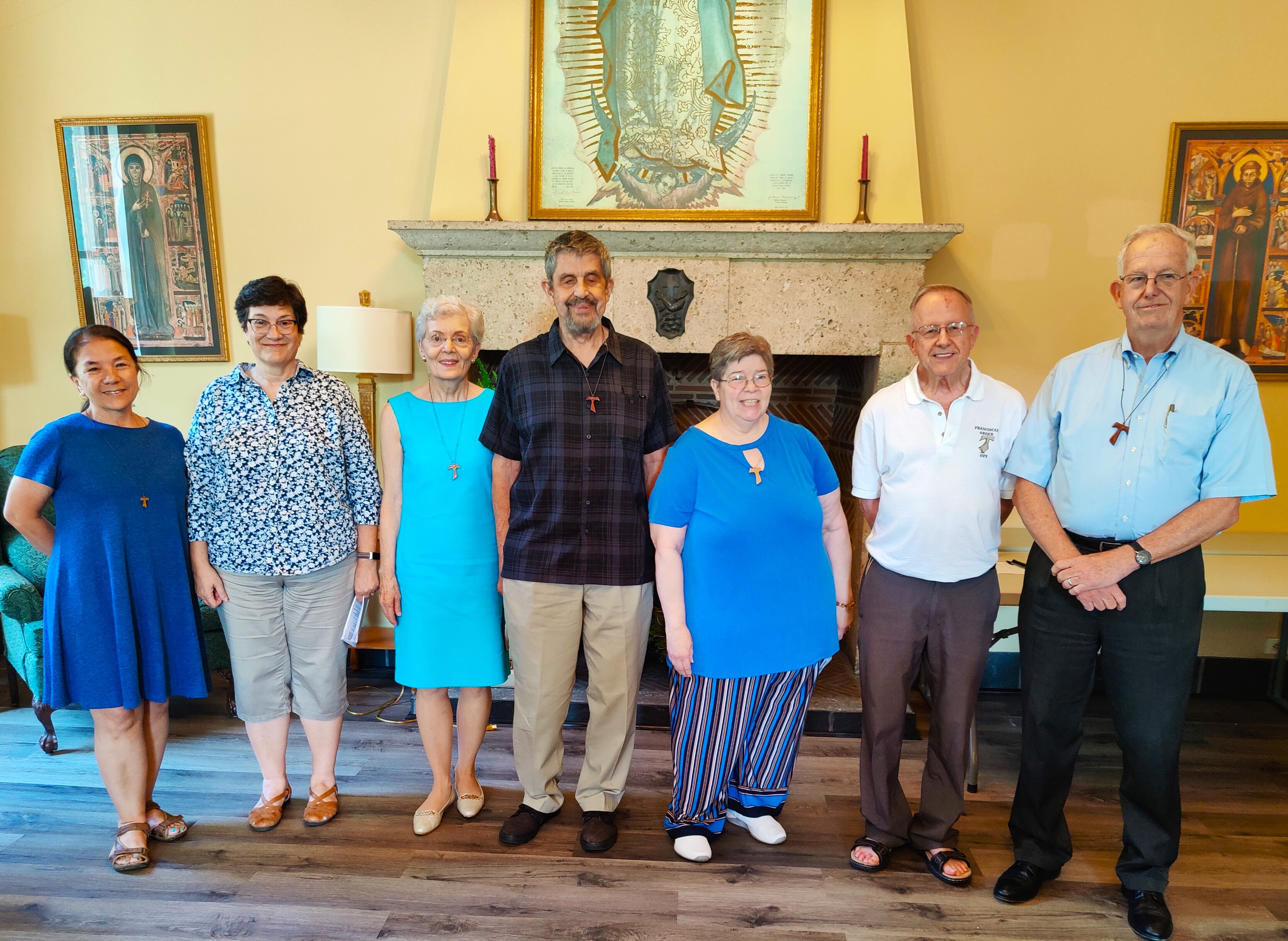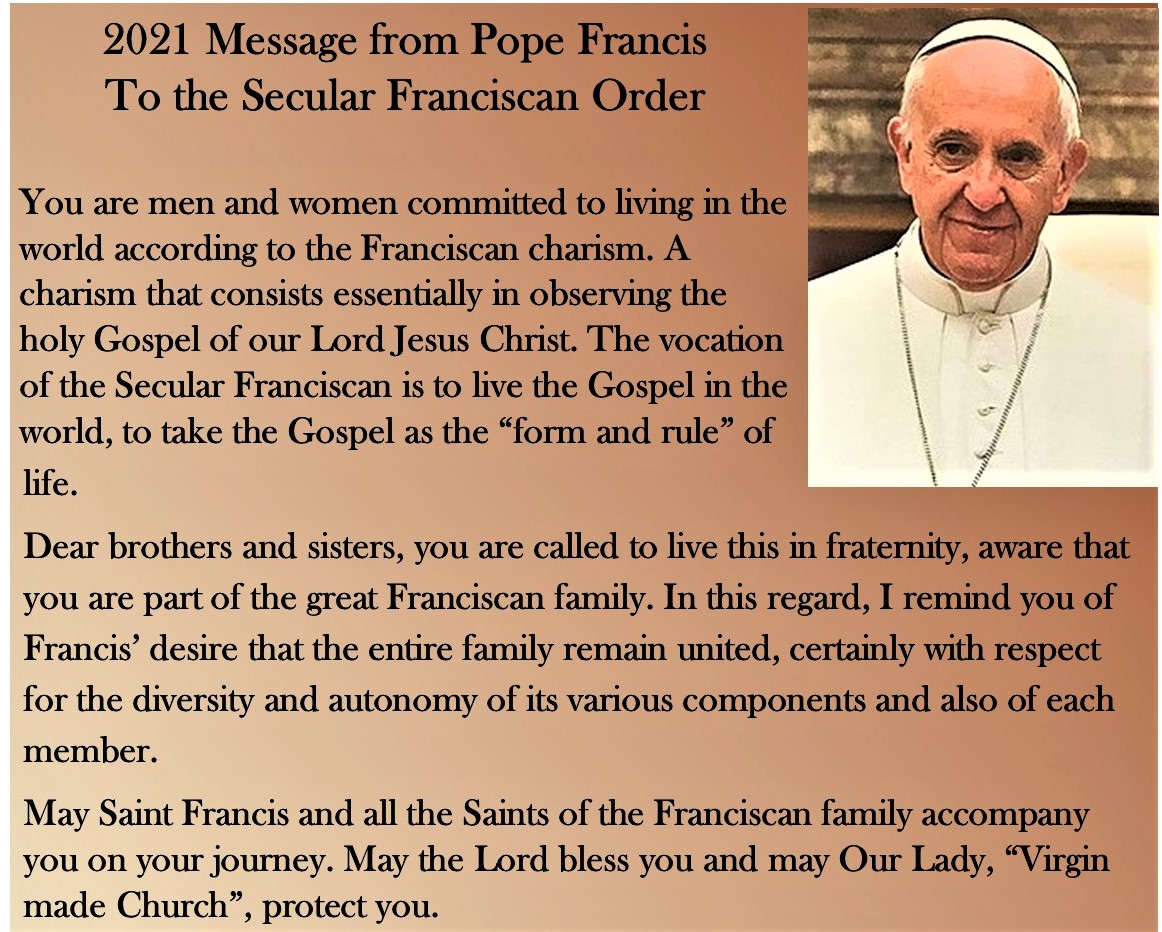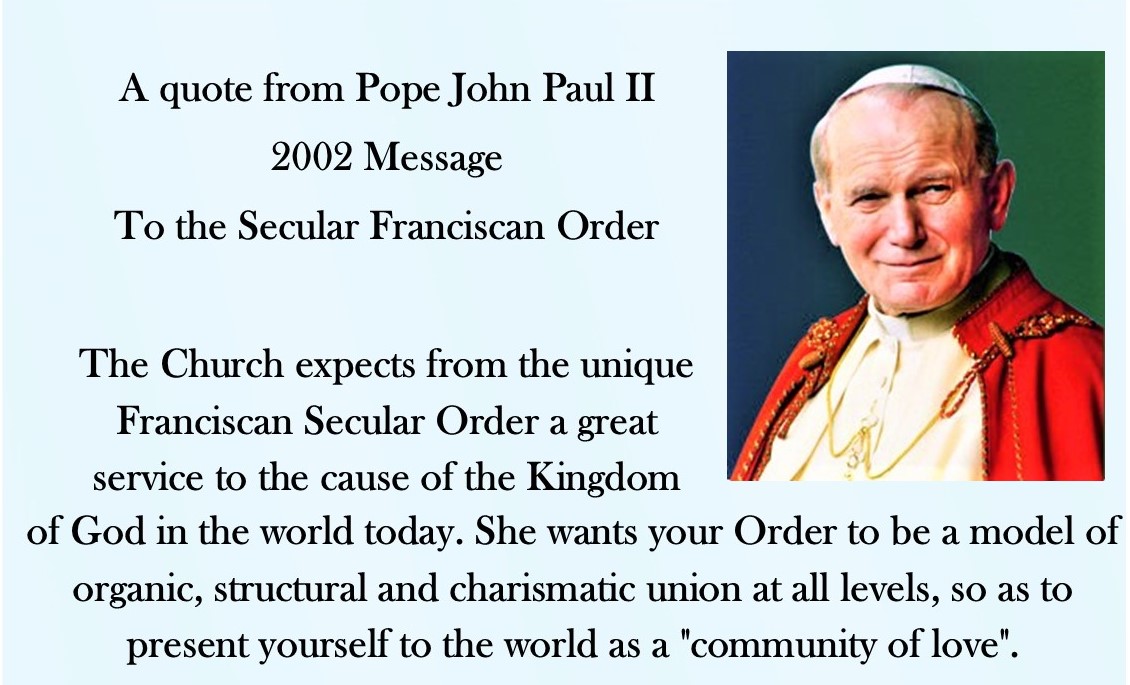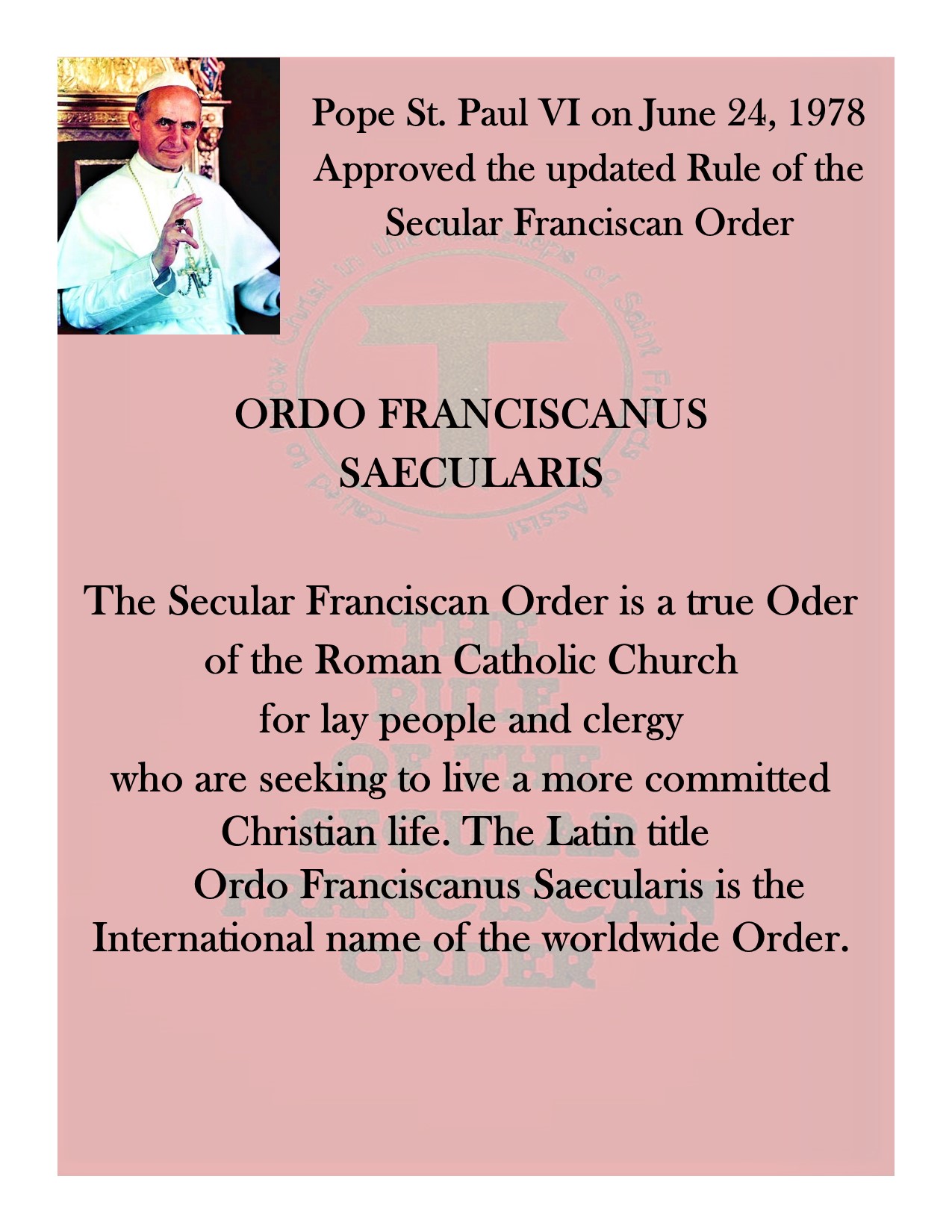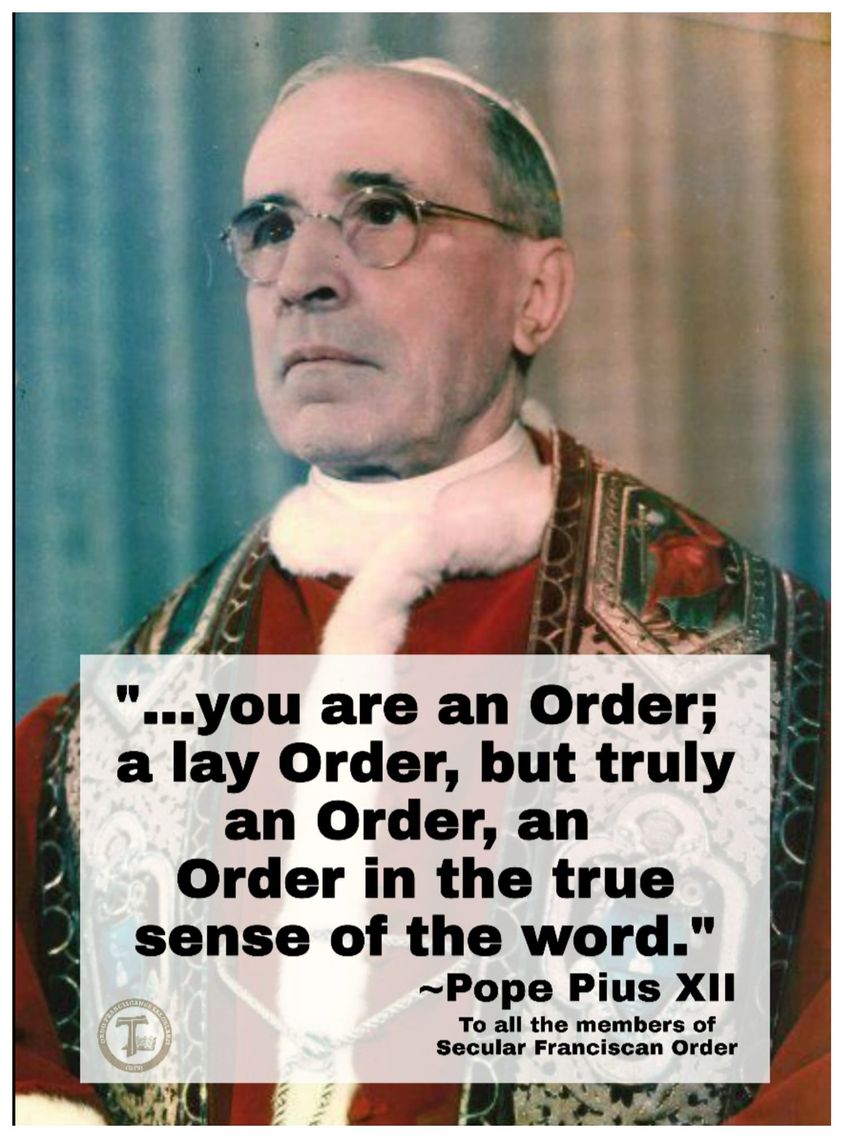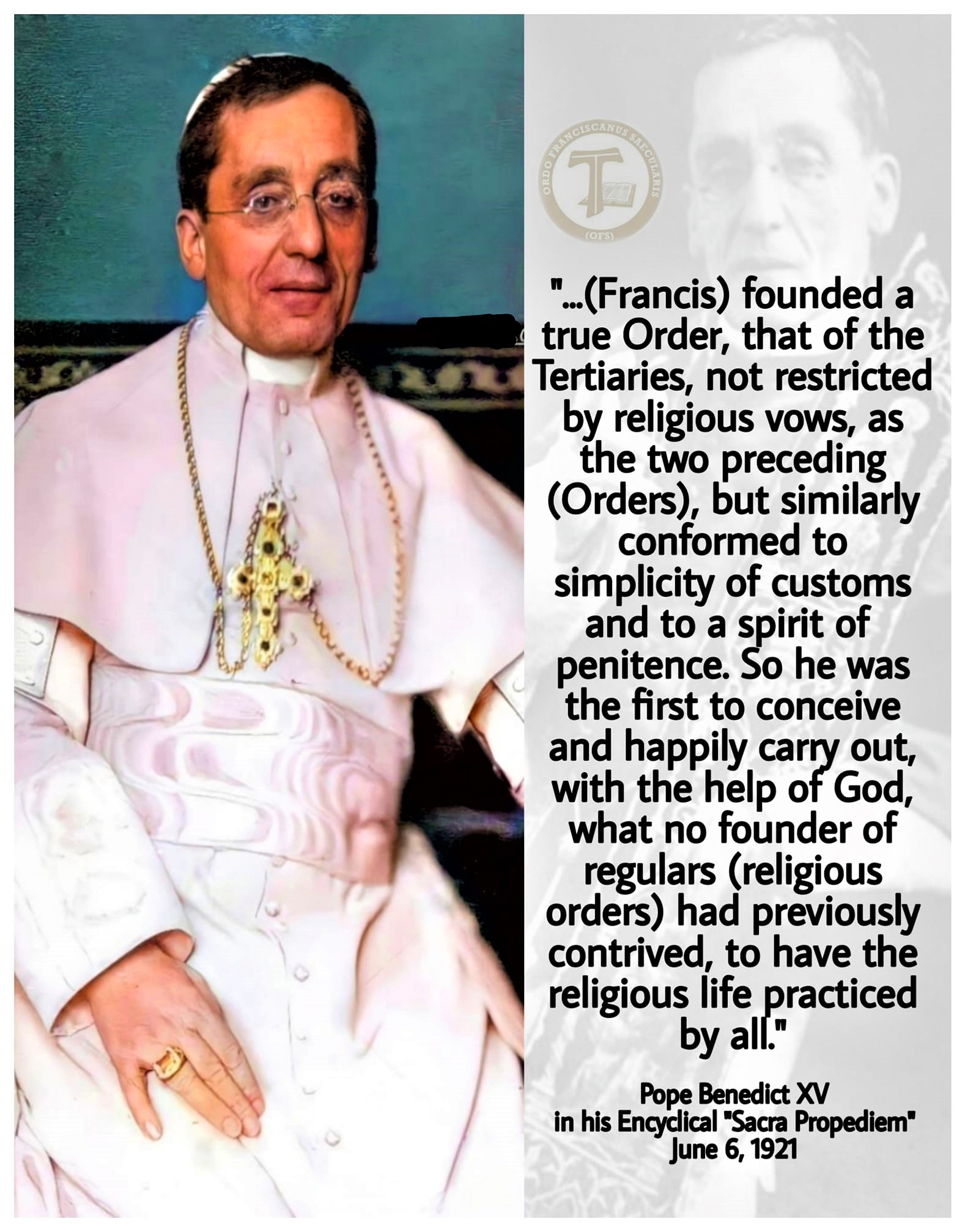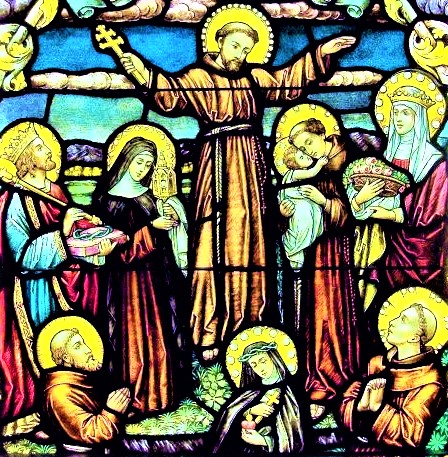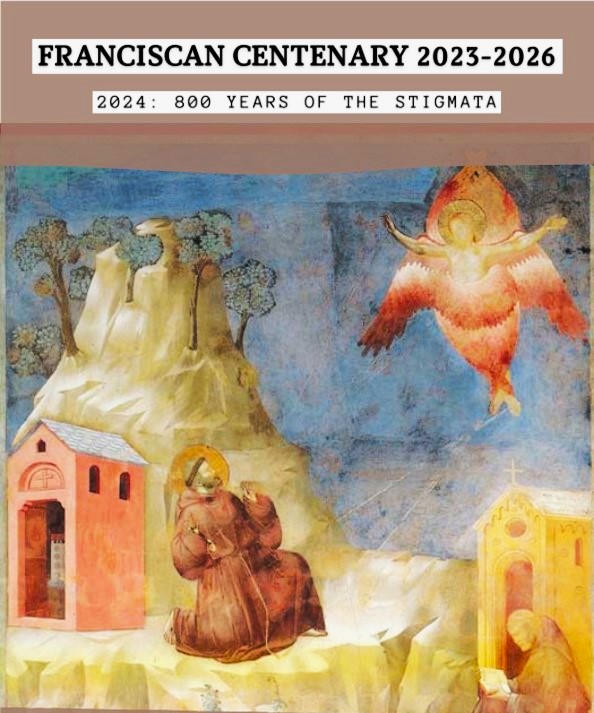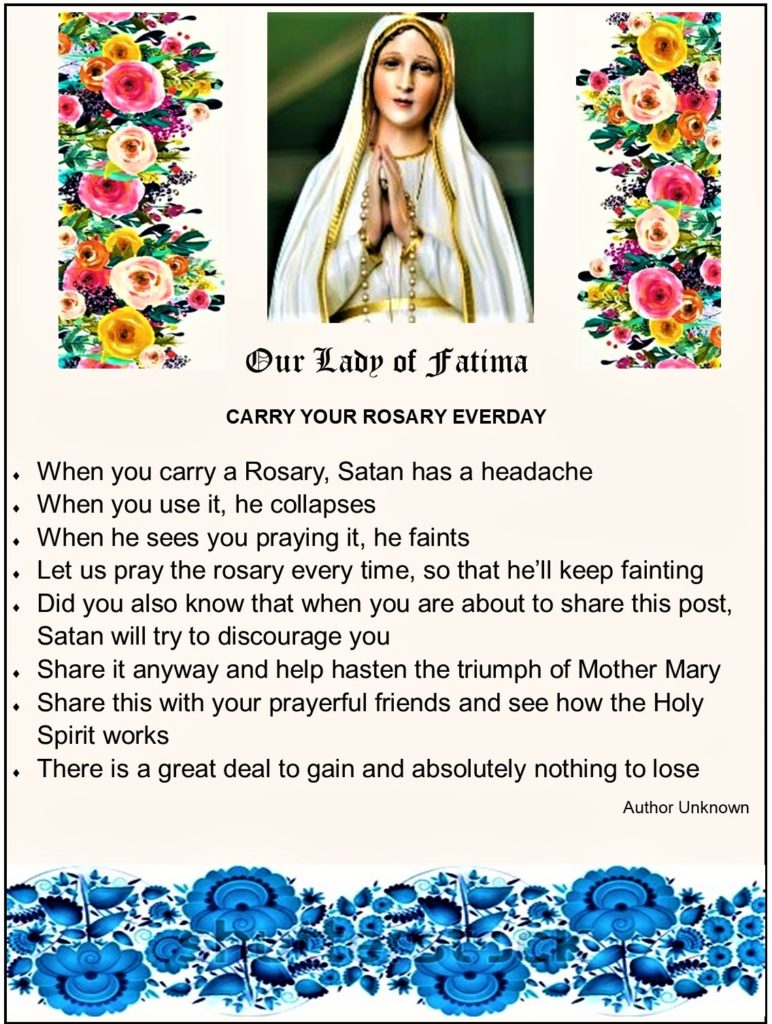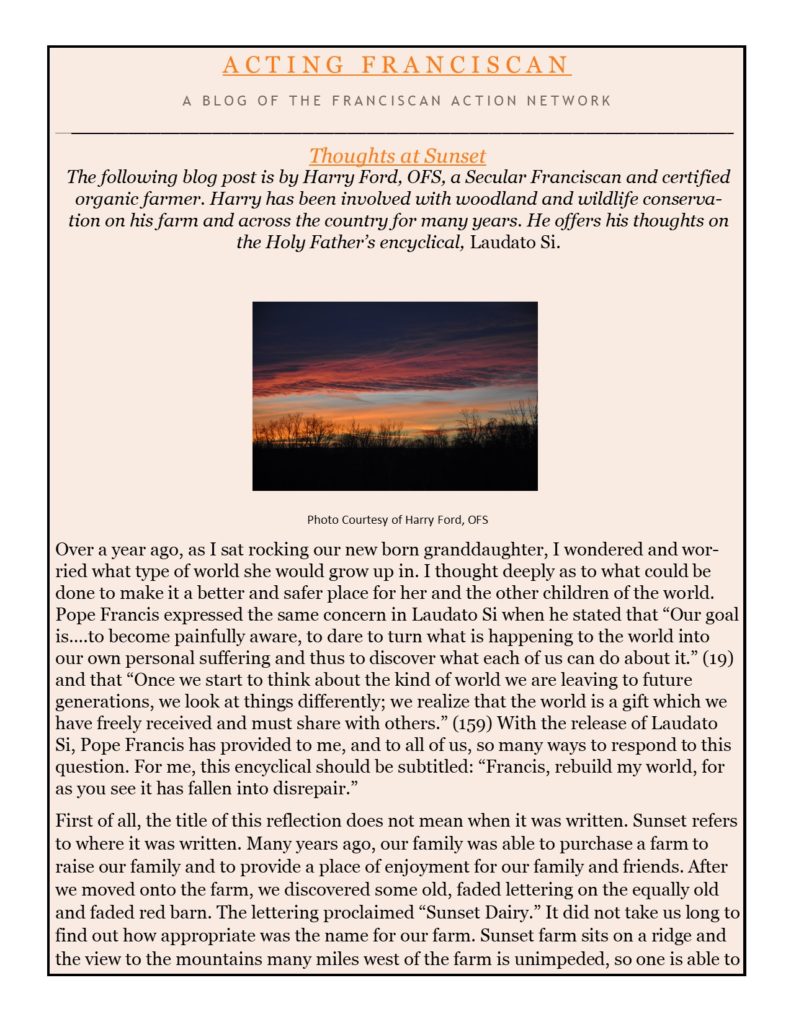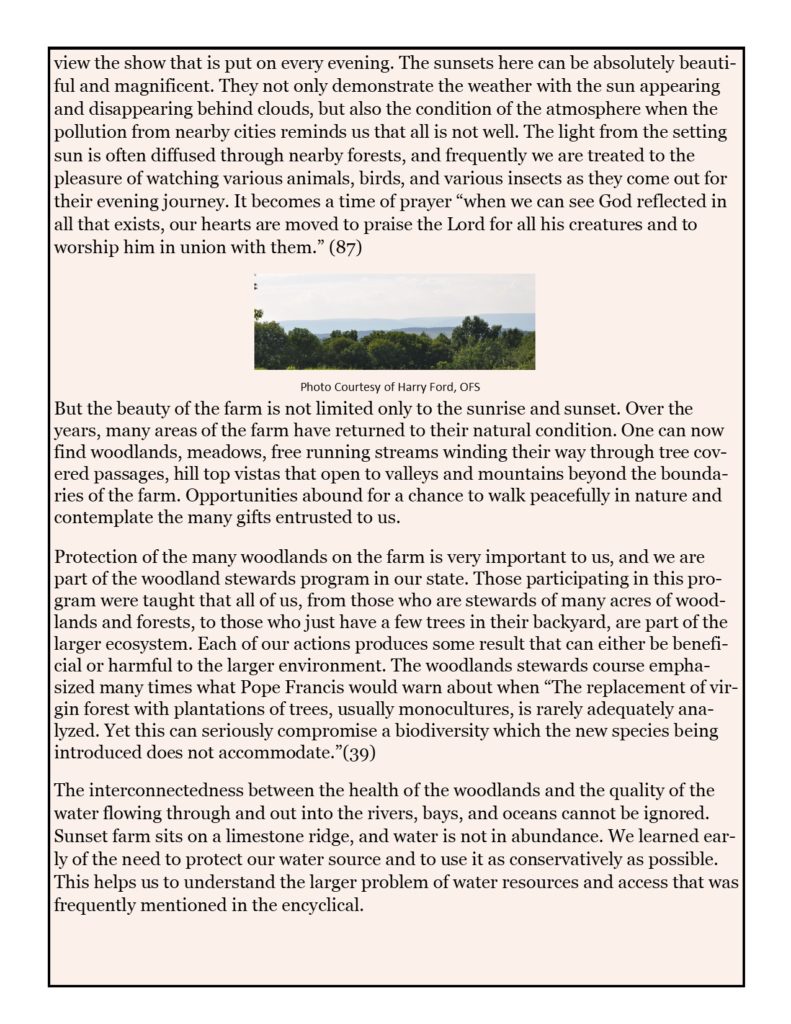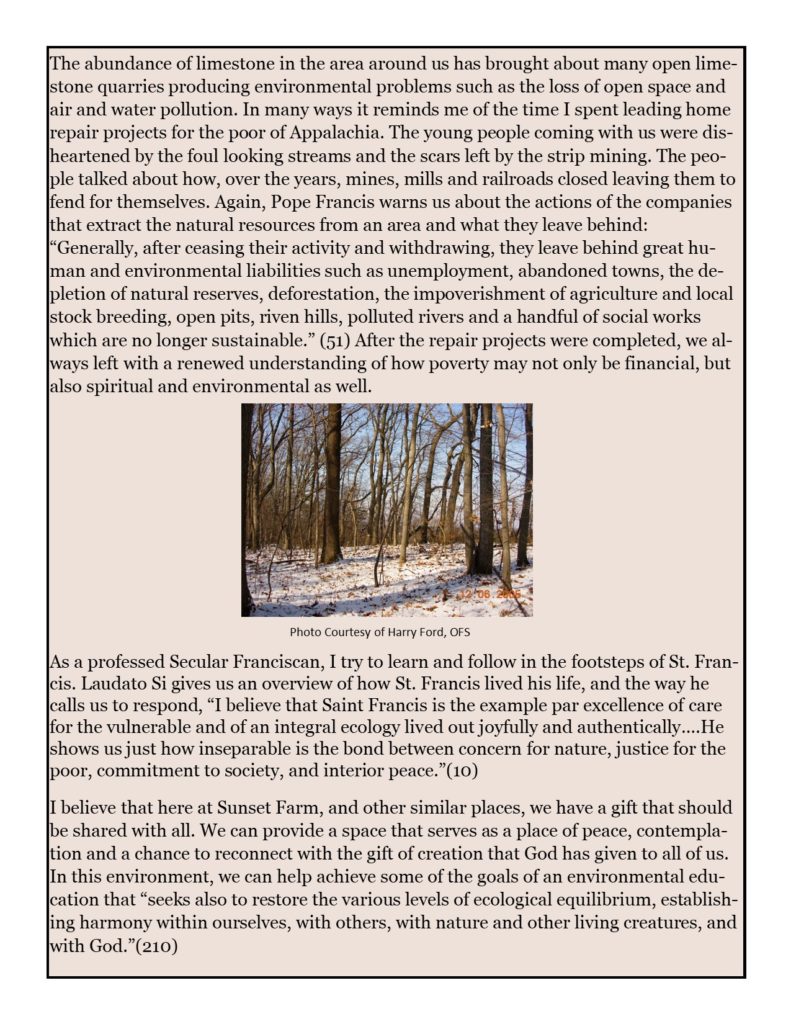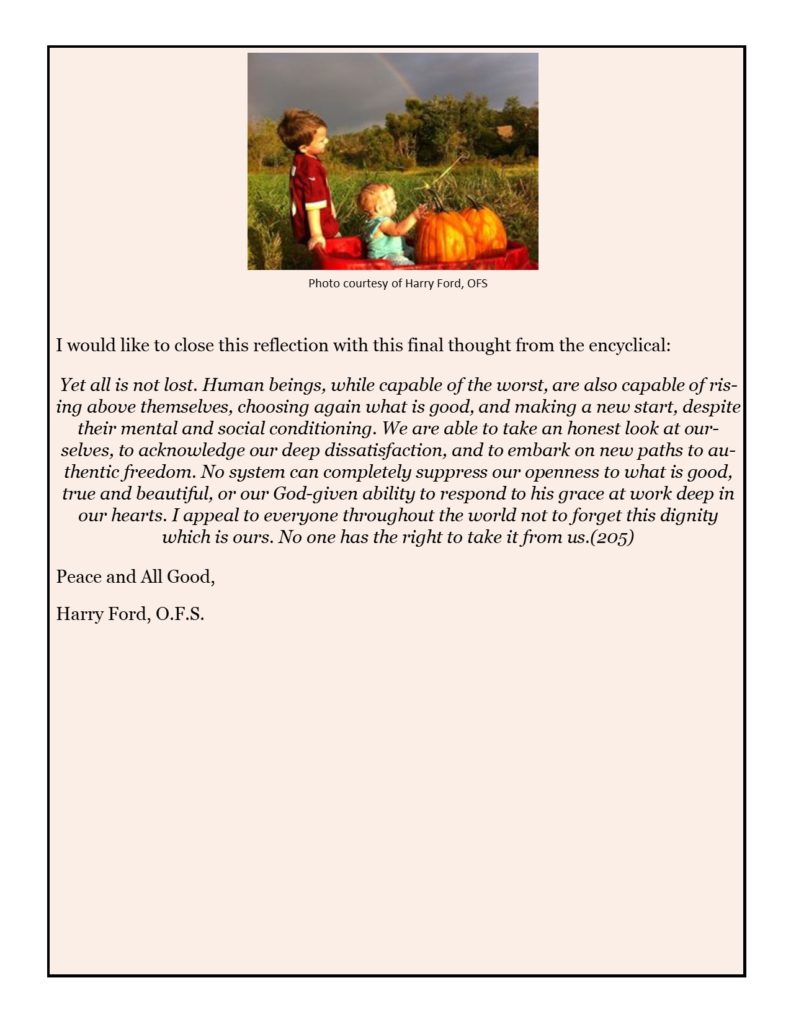*************************
2023 St. Joseph Cupertino Annual Picnic
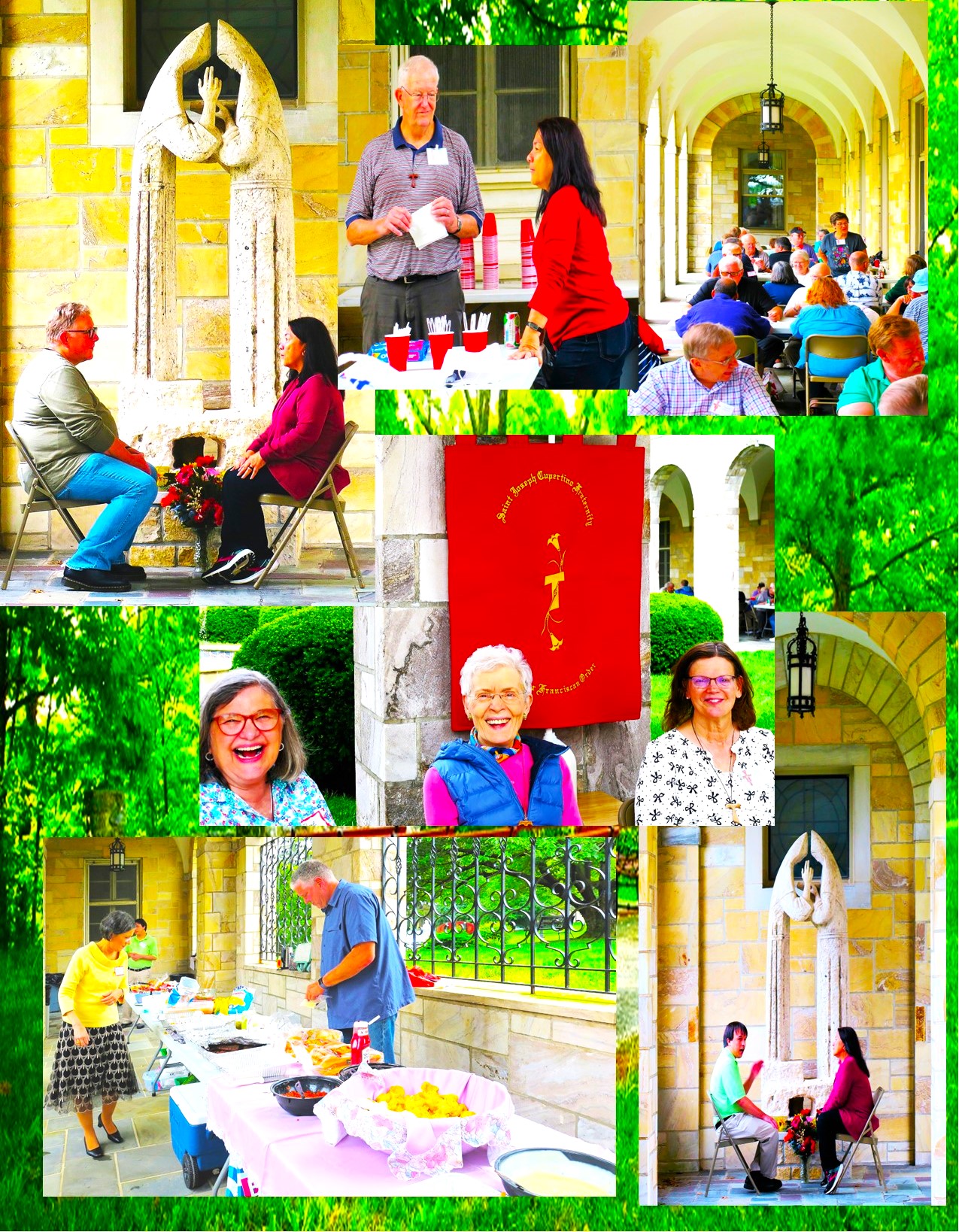

Pope calls Secular Franciscans to closeness, compassion, tenderness
By Vatican News staff writer
ADDRESS OF HIS HOLINESS POPE FRANCIS
TO THE PARTICIPANTS IN THE GENERAL CHAPTER OF THE SECULAR FRANCISCAN ORDER
Clementine Hall
Monday, 15 November 2021
___________________________
Dear brothers and sisters of the Franciscan Secular Order, good morning!
I greet you with the words Saint Francis addressed to those he met along the way: “The Lord give thee peace!”. I am pleased to welcome you on the occasion of your General Chapter. In this context I would like to recall some elements proper to your vocation and mission.
Your vocation is born of the universal call to holiness. The Catechism of the Catholic Church reminds us that “lay people share in Christ’s priesthood: ever more united with Him, they exhibit the grace of Baptism and Confirmation in all dimensions of their personal family, social and ecclesial lives, and fulfil the call to holiness addressed to all the baptized”.
This holiness, to which you are called as Secular Franciscans, as the General Constitutions and the Rule approved by Saint Paul VI ask of you, involves the conversion of the heart, attracted, conquered and transformed by the One who is the only Holy One, who is “the good, every good, the supreme good” (Saint Francis, Praises of God Most High). This is what makes you true “penitents”. Saint Francis, in his Letter to all the faithful, presents “doing penance” as a path of conversion, a path of Christian life, a commitment to do the will and works of the heavenly Father. In his Testament, he describes his own process of conversion in these words, which you know well: “The Lord gave to me, Brother Francis, thus to begin to do penance; for when I was in sin it seemed to me very bitter to see lepers. … And when I left them, that which had seemed to me bitter was changed for me into sweetness of body and soul. And afterwards I remained a little and I left the world (1-3).
The process of conversion is thus: God takes the initiative: “The Lord gave to me to begin to do penance”. God leads the penitent to places where he would never have wanted to go: “God led me among them, the lepers”. The penitent responds by accepting to place himself at the service of others and by using mercy with them. And the result is happiness: “That which had seemed to me bitter was changed into sweetness of mind and body”. Exactly the path of conversion taken by Francis.
This, dear brothers and sisters, is what I urge you to achieve in your lives and in your mission. And, please, let us not confuse “doing penance” with “works of penance”. These – fasting, almsgiving, mortification – are consequences of the decision to open one’s heart to God. Open your heart to God! To open one’s heart to Christ, living in the midst of ordinary people, in the style of Saint Francis. Just as Francis was a “mirror of Christ”, so may you too become “mirrors of Christ”.
You are men and women committed to living in the world according to the Franciscan charism. A charism that consists essentially in observing the holy Gospel of our Lord Jesus Christ. The vocation of the Secular Franciscan is to live the Gospel in the world in the style of the Poverello, sine glossa; to take the Gospel as the “form and rule” of life. I urge you to embrace the Gospel as you embrace Jesus. Let the Gospel, that is, Jesus Himself, shape your life. In this way you will take on poverty, minority and simplicity as your distinguishing marks before all.
With this Franciscan and secular identity of yours, you are part of the outbound Church. Your favourite place to be is in the midst of the people, and there, as lay people – celibate or married -, priests and bishops, each according to his or her specific vocation, to bear witness to Jesus with a simple life, without pretension, always content to follow the poor and crucified Christ, as did Saint Francis and so many men and women of your Order. I encourage you too to go out to the peripheries, the existential peripheries of today, and there to make the word of the Gospel resound. Do not forget the poor, who are the flesh of Christ: you are called to proclaim the Good News to them (cf. Lk 4:18), as did, among others, Saint Elizabeth of Hungary, your Patroness. And just as the “fraternities of penitents” of yesteryear distinguished themselves by founding hospitals, dispensaries, soup kitchens and other works of genuine social charity, so today the Spirit sends you to exercise the same charity with the creativity required by the new forms of poverty.
May your secularity be full of closeness, compassion and tenderness. And may you be men and women of hope, committed to living it and also to “organising” it, translating it into real everyday situations, in human relations, in social and political engagement; nurturing hope in tomorrow by alleviating the pain of today.
And, dear brothers and sisters, you are called to live this in fraternity, aware that you are part of the great Franciscan family. In this regard, I remind you of Francis’ desire that the entire family remain united, certainly with respect for the diversity and autonomy of its various components and also of each member. But always in a lively mutual communion, to dream together a world in which we are all, and all feel, that we are brothers, and working together to build it (cf. Encyclical Letter Fratelli tutti, 8): men and women who fight for justice, and who work for an integral ecology, collaborating in missionary projects and making yourselves artisans of peace and witnesses to the Beatitudes.
In this way we started out with the path of conversion, and then all these proposals of fruitfulness, that come from the heart joined to the Lord, and that loves poverty. May Saint Francis and all the Saints of the Franciscan family accompany you on your journey. May the Lord bless you and may Our Lady, “Virgin made Church”, protect you. And please do not forget to pray for me. Thank you.
______________________________________
Bulletin of the Holy See Press Office, 15 November 2021
**************************************************
**************************************************
Living Franciscan Spirituality with Henri Nouwen
**************************************************
You know you’re a Secular Franciscan when:
- You notice an unmistakable lack in desire to acquire more stuff
- Peacemaking becomes incredibly attractive to you
- Your eyes fill up when you hear about a trip to Assisi
- You want to dress (and LIVE) more and more simply
- Christmas is for you the greatest feast day
- You take off work on October 4
- You laugh loudly and often when you get together with other Franciscans
- You hug people a lot, especially other Franciscans
- All your gatherings are noted for having to much and wonderful food
- You follow the Franciscan Saint of the Day religiously
- The term “fair share” not only means something to you, you try to give more than your fair share to the common fund
- You read the TAU-USA from cover to cover
- You’ve read several books by Lester Bach, OFM Cap, and look forward to him writing more
- “Little Red Book” means “Holy Rule” to you and not something by Chairman Mao
- You don’t have to dust off your TAU every month to wear it to the monthly meeting, you wear it every day everywhere
- You like all Saint Francis statues, even the ones with the birds
- You have or want to have a Francis-in a-birdbath
- You could open your own Franciscan religious goods store with all the Franciscan memorabilia you have
- Your rosaries have seven decades
- You can sing “Make Me a Channel of Your Peace” without ever looking at the hymnal
- You recycle everything – I mean EVERYTHING
- You hear a Francis or Clare story and think, “This would be good for ongoing formation.”
- You know what CNSA stands for, as well as CIOFS and NAFRA
- You can define “the Q” and “NEC”
- You can distinguish an OFM habit from a Capuchin one
- Your profession date is more important to you than your birthday
- Your Liturgy of the Hours goes everywhere with you
- You receive the Eucharist and it’s the high point of your day.
- You support all life issues and not just one
- *(and one zinger!)
- Who is on the regional or national executive council and what they do is a complete mystery to you!
Compiled by Fr. Kevin Queally, TOR
National Spiritual Assistant to the SFO
(Permission to use granted by Fr. Kevin)
**************************************************
Divine Office: This prayer of the monastics has changed everything
**************************************************
Conversion Story of Dr. Bernard Nathanson
From our brother, James Kim, OFS:
**************************************************
12-weeks-of-Franciscan-Peace
**************************************************
Saints for Sinners
I would like to introduce a book I recently read. It’s so impressive that I like to share this book with the brothers and sisters in the Fraternity.
It’s “Saints for Sinners.” The author is Alban Goodier (early 1900th), a Jesuit and bishop. It includes stories of nine saints. The stories show how God guided each of the saints in a unique way and had them overcome their difficulties and trials.
The author’s point is:
“God chose the foolish of the world to shame the wise, and God chose the weak of the world to shame the strong, and God chose the lowly and despised of the world, those who count for nothing, to reduce to nothing those who are something, so that no human being might boast before God.” (1 Cor 1:27-29).
It includes three Franciscan saints, St. Joseph of Cupertino, St. Margaret of Cortona, and St. Benedict Joseph Labre (OFS).
Amazon Kindle version is free now. (It was $1).
The saints in this book are:
- St. Augustin,
- St. Margaret of Cortona,
- St. John of God,
- St. Francis Xavier,
- St. John of the Cross,
- St. Camillus de Lellis,
- St. Joseph of Cupertino,
- Bl. Claude de La Colombiere (Saint now),
- St. Benedict Joseph Labre.
by James Kim, OFS
**************************************************
Thoughts at Sunset by Harry Ford, OFS
**************************************************
Bequest Pamphlet
Our National Bequest and Endowment Committee, chaired by National Councilor Mary Frances Charsky, has generated a Bequest Form (Pamphlet) for those who would like to continue to support the legacy of the Secular Franciscan Order when our journey has ended.
The pamphlet reminds our sisters and brothers that we are a family and our legacy can be remembered in several ways through contributions and through prayers. As a family, we plan to continue to support each other.
In Matthew’s Gospel (Matthew 6:1-6, 16-18):
“A very good way of atoning for our sins is by being generous to the poor. Fasting is better than prayer, but almsgiving surpasses both, for love covers a multitude of sins. Nevertheless, prayer delivers the soul from death if it proceeds from a good conscience.”
To view the Bequest Pamphlet click on the URL’s below:
If you are having trouble downloading this form please contact Mary Frances (mfcharsky@gmail.com)
**************************************************
A DC “Secret” Uncovered
**************************************************
A New Manuscript on the Life of St. Francis, the exceptional discovery that fills us with joy
**************************************************
Death with Dignity
**************************************************
The Power of Prayer
Someone has said that if Christians really understood the full extent of the power we have available through prayer, we might be speechless. During WWII there was an adviser to Churchill who organized a group of people who dropped what they were doing every day at a prescribed hour for one minute to collectively pray for the safety of England, its people, and peace. There is now a group of people organizing the same thing here in America. If you would like to participate every evening at 9:00 PM Eastern Time (8:00 PM Central) (7:00 PM Mountain) (6:00 PM Pacific), stop whatever you are doing and spend one minute praying for the safety of the United States and for a return to a Godly Nation. If you know anyone else who would like to participate, please pass this along. Our prayers are the most powerful asset we have. – Jerry Yu, OFS
**************************************************
Finding Joy So That We May Serve Others
Joy is the infallible sign of the present of God – Pierre Teilhard de Chardin
SORROW AND JOY ARE COMPATIBLE
So also you have sorrow now, but I will see you again, and your hearts will rejoice, and no one will take your joy from you.” [John 16:22]
“Count it all joy, my brothers, when you meet trials of various kinds, for you know that the testing of your faith produces steadfastness.” James 1:2-3
Blessed are you when people hate you, when they exclude you and insult you and reject your name as evil, because of the Son of Man. Rejoice in that day and leap for joy, because great is your reward in heaven. For that is how their ancestors treated the prophets.” –Luke 6:22-23
Reflection on Sorrow and Joy: Both run parallel until at some point they merge together at the horizon—at that point in our lives when we are able to “live into” our pain and see the joy of the Lord.
JOY IS A GIFT OF THE HOLY SPIRIT
But the fruit of the Spirit is love, joy, peace, patience, kindness, goodness, faithfulness,” [Galatians 5:22]
JOY IS BOTH COMPATIBLE WITH SORRY AND COMES FROM THE HOLY SPIRIT
“And you became imitators of us and of the Lord, for you received the word in much affliction, with the JOY of the Holy Spirit,” 1 Thessalonians 1:6
JOY IS A SIGN OF GOD’S PRESENCE
These things I have spoken to you, that my joy may be in you, and that your joy may be full.” [John 15:11]
Shout, and sing for joy, O inhabitant of [Margaret of Cortona Region], for great in your midst is the Holy One of Israel.” Isaiah 12:6
Though you have not seen him, you love him. Though you do not now see him, you believe in him and rejoice with joy that is inexpressible and filled with glory,” 1 Peter 1:8
Our mouths were filled with laughter, our tongues with songs of joy. Then it was said among the nations, “The Lord has done great things for them.” The Lord has done great things for us, and we are filled with joy. – Psalm 126:2-3
JOY IS IN RELATIONSHIP WITH OTHER VIRTUES
May the God of hope fill you with all JOY and peace in believing, so that by the power of the Holy Spirit you may abound in hope. Romans 15:13
Be full of JOY in the Lord always. I will say again, be full of JOY. Let everyone see that you are gentle and kind. The Lord is coming soon” Philippians 4:4-5
For the kingdom of God is not a matter of eating and drinking but of righteousness and peace and JOY in the Holy Spirit.” Romans 14:17
May the God of hope fill you with all JOY and peace in believing, so that by the power of the Holy Spirit you may abound in hope. Romans 15:13
JOY CASTS OUT FEAR
And the angel said to them, “Fear not, for behold, I bring you good news of great joy that will be for all the people.” Luke 2:10
JOY VANQUISHES EVIL
The hope of the righteous brings joy, but the expectation of the wicked will perish. Proverbs 10:28
JOY AND SALVATION
Jesus said, “The kingdom of heaven is like treasure hidden in a field. When a man found it, he hid it again, and then in his joy went and sold all he had and bought that field” – Matthew 13:44
JOY IS WRAPPED UP IN RELATIONSHIP!
Put on then, as God’s chosen ones, holy and beloved, compassionate hearts, kindness, humility, meekness, and patience, bearing with one another and, if one has a complaint against another, forgiving each other; as the Lord has forgiven you, so you also must forgive. And above all these put on love, which binds everything together in perfect harmony [and I add JOY]. Colossians 3:12-14
Listen to each scripture reading and allow the words, images, or sentences in the readings resonate with your personal life experiences. Stay with those insights and allow them to comfort you and give you the strength to serve God and your brothers and sisters.
QUESTIONS
Through what periods of my life have I found myself most joyful?
In what ways has my own suffering been the birth canal for me to know deeper joy in being alive?
Who in my life is the source of joy?
Have I ever experienced joy in one of the worst times of my life?
Anne Mulqueen, OFS—September 27, 2014
**************************************************
Secular Franciscan Order Urges People of Good Will To Take a Cue from the Example of Pope Francis
KANSAS CITY — Leaders of the Secular Franciscan Order have issued an appeal to “all people of goodwill” to take a cue from the example of Pope Francis and embrace the world in love in their everyday lives.
“Pope Francis embraces the ideals close to the heart of Saint Francis of Assisi himself, including love for the poor and marginalized, care for creation, and peacemaking,” the Order’s national chapter said in a statement while meeting in Kansas City, KS, Oct. 19. “He vividly shows us that no individual is far from the heart of God, and thus, no individual may be rejected.”
The leaders, representing more than 13,000 Secular Franciscans across the U.S. and in Guam, cited the pope’s “bold peacemaking initiatives,” including the “daring call to the world to fast and pray” over the war in Syria. “We wish to affirm and promote the spirit of nonviolence and reconciliation embodied by his words and witness… We support his efforts to embrace the world in love and to remind us of our call to be accepting of all people, recognizing that in mercy there is also justice.”
They added: “As Secular Franciscans we pledge to work together to build a society which embraces these Gospel values. We, therefore, commit ourselves to prayer and compassionate action.”
**************************************************
Chapter of the Secular Franciscan Order
“To follow Jesus means putting him first and stripping ourselves of all the things that oppress our hearts.” -Pope Francis
We, the members of the National Fraternity of the Secular Franciscan Order, have gathered at Savior Pastoral Center in Kansas City, KS, from October 15 through 20, 2013. Called to be bearers of peace, we welcome the bold peacemaking initiatives of Pope Francis. We wish to affirm and promote the spirit of nonviolence and reconciliation embodied by his words and witness.
We believe the seemingly inevitable build-up toward war in Syria was halted in part because of Pope Francis’ daring call to the world to fast and pray. Many efforts, including his, resulted in a nonviolent resolution of that stand-off. We support his efforts to embrace the world in love and to remind us of our call to be accepting of all people, recognizing that in mercy there is also justice.
We publicly and strongly affirm the Holy Father as he continues to model the consistent ethic of life in his commitment and fidelity to Catholic Social Teaching. We rejoice that Pope Francis embraces the ideals close to the heart of Saint Francis of Assisi himself, including love for the poor and the marginalized, care for creation, and peacemaking.
We exhort all our sister and brother Franciscans, all Catholics and Christians, and all people of goodwill to heed the example of Pope Francis as he daily models the heart and soul of charity and works for the betterment of humankind. He vividly shows us that no individual is far from the heart of God, and thus no individual may be rejected. As Secular Franciscans, we pledge to work together to build a society that embraces these gospel values. We, therefore, commit ourselves to prayer and compassionate action.
**************************************************
